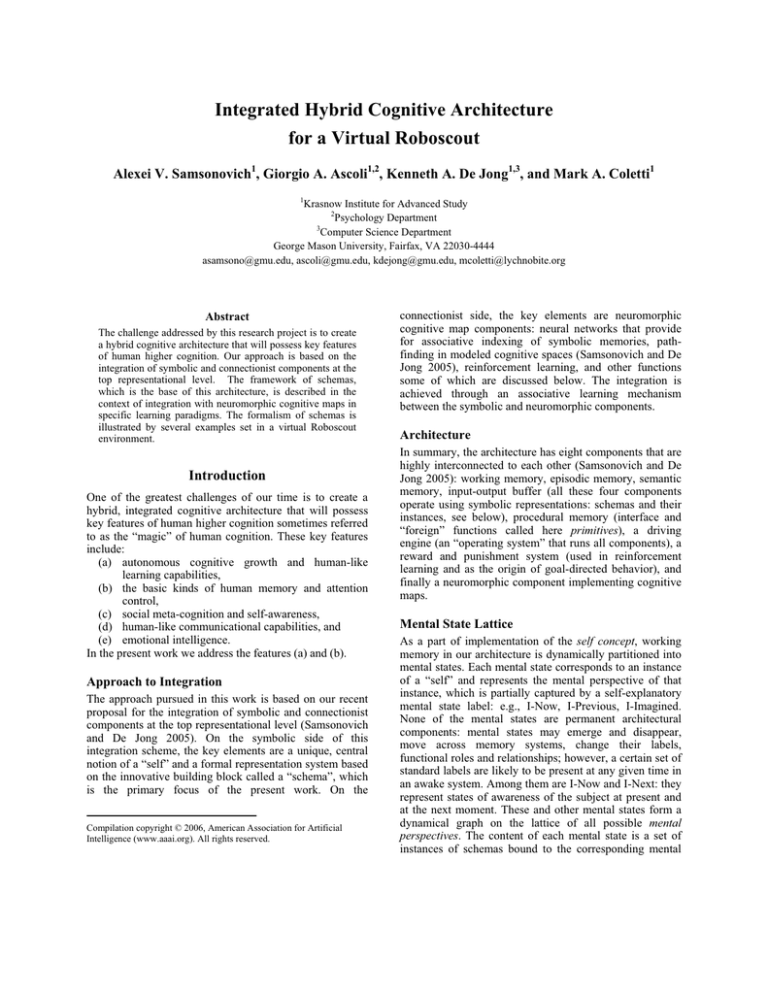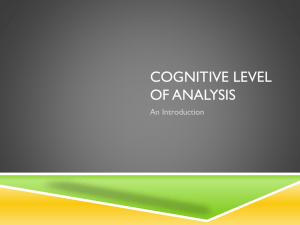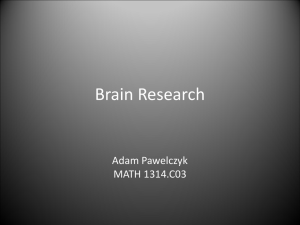
Integrated Hybrid Cognitive Architecture
for a Virtual Roboscout
Alexei V. Samsonovich1, Giorgio A. Ascoli1,2, Kenneth A. De Jong1,3, and Mark A. Coletti1
1
Krasnow Institute for Advanced Study
2
Psychology Department
3
Computer Science Department
George Mason University, Fairfax, VA 22030-4444
asamsono@gmu.edu, ascoli@gmu.edu, kdejong@gmu.edu, mcoletti@lychnobite.org
Abstract
The challenge addressed by this research project is to create
a hybrid cognitive architecture that will possess key features
of human higher cognition. Our approach is based on the
integration of symbolic and connectionist components at the
top representational level. The framework of schemas,
which is the base of this architecture, is described in the
context of integration with neuromorphic cognitive maps in
specific learning paradigms. The formalism of schemas is
illustrated by several examples set in a virtual Roboscout
environment.
Introduction
One of the greatest challenges of our time is to create a
hybrid, integrated cognitive architecture that will possess
key features of human higher cognition sometimes referred
to as the “magic” of human cognition. These key features
include:
(a) autonomous cognitive growth and human-like
learning capabilities,
(b) the basic kinds of human memory and attention
control,
(c) social meta-cognition and self-awareness,
(d) human-like communicational capabilities, and
(e) emotional intelligence.
In the present work we address the features (a) and (b).
Approach to Integration
The approach pursued in this work is based on our recent
proposal for the integration of symbolic and connectionist
components at the top representational level (Samsonovich
and De Jong 2005). On the symbolic side of this
integration scheme, the key elements are a unique, central
notion of a “self” and a formal representation system based
on the innovative building block called a “schema”, which
is the primary focus of the present work. On the
Compilation copyright © 2006, American Association for Artificial
Intelligence (www.aaai.org). All rights reserved.
connectionist side, the key elements are neuromorphic
cognitive map components: neural networks that provide
for associative indexing of symbolic memories, pathfinding in modeled cognitive spaces (Samsonovich and De
Jong 2005), reinforcement learning, and other functions
some of which are discussed below. The integration is
achieved through an associative learning mechanism
between the symbolic and neuromorphic components.
Architecture
In summary, the architecture has eight components that are
highly interconnected to each other (Samsonovich and De
Jong 2005): working memory, episodic memory, semantic
memory, input-output buffer (all these four components
operate using symbolic representations: schemas and their
instances, see below), procedural memory (interface and
“foreign” functions called here primitives), a driving
engine (an “operating system” that runs all components), a
reward and punishment system (used in reinforcement
learning and as the origin of goal-directed behavior), and
finally a neuromorphic component implementing cognitive
maps.
Mental State Lattice
As a part of implementation of the self concept, working
memory in our architecture is dynamically partitioned into
mental states. Each mental state corresponds to an instance
of a “self” and represents the mental perspective of that
instance, which is partially captured by a self-explanatory
mental state label: e.g., I-Now, I-Previous, I-Imagined.
None of the mental states are permanent architectural
components: mental states may emerge and disappear,
move across memory systems, change their labels,
functional roles and relationships; however, a certain set of
standard labels are likely to be present at any given time in
an awake system. Among them are I-Now and I-Next: they
represent states of awareness of the subject at present and
at the next moment. These and other mental states form a
dynamical graph on the lattice of all possible mental
perspectives. The content of each mental state is a set of
instances of schemas bound to the corresponding mental
perspective and to each other. The underlying schemaoriented representation formalism that was described
previously at an abstract level (Samsonovich and De Jong
2005) is specifically designed to enable cognitive growth
capabilities and to allow for indexing, retrieval, and
organization of memories by the connectionist component.
This formalism is addressed in the following section.
Cognitive Map
The neuromorphic cognitive map component includes: (1)
a contextual map that indexes episodic memories, (2) a
conceptual map that indexes semantic memories, and (3) a
separate map for emotional memories that may involve
episodes as well as semantic knowledge. The notion of a
(spatial) cognitive map was introduced by O’Keefe and
Nadel (1978). A cognitive map in the present framework is
understood as an abstract multi-dimensional space that is
used to index memories. It can be implemented as a (subset
of) the phase space of a neural network (e.g., an attractor).
Therefore, points of the map correspond to dynamical
states of the network (patterns of activity). The map can be
linked to symbolic memory traces via associative learning.
Virtual Roboscout Paradigm
One possible scenario in which the architecture can be
used is the ontogenesis of an agent embedded in a virtual
urban scout environment (snapshot shown in Figure 3 A).
This general paradigm can be called “a Car World”.
The embodied agent is born as a car in a virtual city. It
has innate senses, effectors, cognitive abilities and values.
The ontogeny of the agent is based on a sequence of
scenarios that can be viewed as a specially designed
“training facility”. These scenarios will be designed to
allow the agent to incrementally acquire new cognitive
abilities. Some of them may require interactions with an
instructor or with other cars controlled by similar virtual
agents or human participants. Success in each new scenario
will depend on the ability to use previously acquired
knowledge. With this general setup, several test scenarios
and metrics can be proposed that should specifically
address the higher cognitive dimensions (a) and (b) listed
above: the “magic” of human cognition.
(Johnson-Laird 1983), “specialists” in polyscheme (Trafton
et al. 2005). The idea of our approach is fusion and
generalization of the above.
On the other hand, the term “schema” originally
introduced by Immanuel Kant in the XVIII century is
currently used in many fields of science, with dozens of
different semantics, some of which appear to be close to
our understanding of this term (e.g., Barsalou 1999).
We previously pointed to several distinguishing features
of our notion of a schema, one of which is its universal
versatility. A schema can be used to represent virtually
anything, from an arbitrary set of mental categories
(including abstract and concrete concepts, feelings, qualia,
actions, volitions, etc.) to a notion as specific as a
particular object taken at one particular moment of time.
Similar to classes in an object-oriented framework, our
schemas give rise to their instances (also called cognitive
states); schemas may be composed of other schemas; more
specific schemas can descend from more general schemas,
inheriting some of their features; and most importantly,
arbitrary new schemas can be created by schemas.
All symbolic components of our architecture are based
on the formalism of schemas (Figure 1). We pointed out
previously (Samsonovich and De Jong 2005) that our
notion of a schema allows for a graphical representation.
Indeed, a schema in our framework can be viewed as a
graph structure composed of nodes that are connected to
each other. It remains therefore to explain what are the
nodes and the links of the graph, and how do they evolve
over time. The best way to clarify these details is to
consider specific examples of schemas in action.
Schema Formalism
We previously introduced our notion of a schema
(Samsonovich and De Jong 2005) as an abstract template
used to instantiate mental categories. At that level, our
notion of a schema has so many analogies and synonyms
that it is impossible to list them all here. The top ten
examples would be: classes in an object-oriented
programming framework, UML models (Booch,
Rumbaugh, and Jacobson, 2005), S-expressions in LISP,
frames (Minsky 1975, 1985), productions and operators in
Soar (Laird et al. 1986, 1987; Newell 1990), chunks and
productions in ACT-R (Anderson and Lebiere 1998),
semantic networks, finite state automata, mental models
Figure 1. Essential UML class diagram of
the symbolic core of the architecture. All
nodes of schemas have the standard list of
attributes; this is also true about mental states.
First Example: SVD
Bearing in mind the Car World paradigm (see above), we
start our consideration with the schema that we call the
schema of a simple visible domain (SVD) applicable to
2-D environments. This example is a convenient starting
point for us to develop an understanding of the key
concepts of this framework. Intuitively, given a global 2-D
Cartesian coordinate system, SVD is understood as a
rectangular domain defined by two points (the South-West
Corner, SWC, and the North-East Corner, NEC). By
definition, whenever an agent is located inside SVD, it can
see any other object located inside the same SVD.
Therefore, the schema of SVD can be written as a list of
four elements that we are going to explain below:
(SVD, SWC, NEC, (Obj)*)
(1)
In this representation, each of the elements: SVD, SWC,
NEC, Obj is a name of a node. A node is an atomic token
that has a set of standard attributes (Figure 1) some of
which we describe below. One of the attributes is the name
of the node: it is a string of characters used for labeling the
node. One can think of it as the symbol representing the
node. While the choice of the symbol may be important for
the human intuitive reasoning, it is actually irrelevant to
machine processing of nodes, schemas and instances.
Strictly speaking, the node semantics should be inferred
not from its name, but from another attribute called
Category (cat), which has the value of a pointer to a (set
of) node(s) of the global semantic network of categories,
which is a part of the semantic memory system and is used
to organize semantic memory.
The first node in (1), SVD, has the name of the schema.
This is a consequence of a general rule: the first node of a
schema is called the head and represents the schema itself.
Its name is the name of the schema (or the name of an
instance of the schema, when it appears in the instance).
The category of the head is the category of the schema. In
this framework, there is a one-to-one correspondence
between schemas and categories. I.e., each schema has a
unique category, and each category is associated with its
unique schema. At the same time, the set of all nodes used
in all schemas could be much broader. In particular, the
category of a node could be any subset of the set of
categories indexed by the semantic network.
As long as the semantic network of categories can be
viewed as a hierarchy, this hierarchy will entail certain
inheritance relationships among schemas, according to the
analogy between classes in an object-oriented framework
and schemas in this framework. Intuitively one may expect
this hierarchy to be organized similarly to the human
system of knowledge, starting from the most general
categories (entity, property, relation, event, quantity, etc.)
and going down to specific instances and atomic elements
in the last instance. On the contrary, a given system of
schemas (or, the epistemic state of the agent) does not have
to be complete or even close to completeness.
In addition to schemas that constitute semantic memory,
our framework has primitives that constitute procedural
memory. Accordingly, there are two kinds of nodes that
may appear in schemas: those that refer to schemas and
those that refer to primitives. The main difference between
schemas and primitives is in their implementation. While
schemas are all implemented in one universal format (as
graphs of nodes, where each node has the standard set of
attributes) and are transparent (i.e., all their internal parts
are in principle “visible” and accessible for other schemas
and instances), primitives in general are opaque (“black
boxes”) and allow for a proprietary implementation. As far
as the protocol of binding is concerned, however, there is
no substantial difference between schemas and primitives
referenced by nodes. Therefore, primitives are analogous
to “foreign functions” in the language based on schemas.
While in most cases a schema would be as good a
performer as a primitive (and therefore is favorable due to
its transparency and versatility), in some special cases the
usage of primitives is inevitable. Examples are the inputoutput channels: sensory signal-to-symbol transduction and
the control of effectors and actuators. In addition, in some
special “internal reasoning” cases, while schemas in
principle could be used, primitives provide a much more
rational and powerful choice (built-in arithmetic and logic
operations, standard routines like sorting, etc.).
The fact that there are nodes SWC, NEC, and Obj in (1)
implies that there are corresponding categories (and the
corresponding schemas) available in semantic memory
(here we should be more precise: e.g., instead of SWC and
NEC, semantic memory may have just one schema of a
point; on the other hand, the node Obj may be a template
that matches any of several available schemas of objects:
e.g., an agent and a gas station, while semantic memory
may lack a general schema of a physical object).
How does the SVD schema work? For example, in one
possible scenario, our agent may have tunnel vision: it can
look at only one location at any moment of time.
Furthermore, the agent becomes aware (i.e., reflects in
I-Now) of only a subset of all that it can see. Suppose the
agent looks at some location X, and then traces down to
some location Y, while seeing nothing special during this
focus of attention shift (no objects or walls). Then the
agent is aware of two visible locations X and Y. For an
intelligent agent, it would be natural to assume in this case
that the two points X and Y belong to the same SVD.
Instead, our rather simplistic agent will take this belief for
granted. Here is how this happens. When the agent is
aware of X and Y, its driving engine attempts to map the
SVD schema onto the content of awareness, and succeeds
in binding X and Y to SWC and NEC, respectively (both
nodes SWC and NEC have their mode of binding, or mob
attribute, set to “Find”, which means that under normal
conditions of this schema mapping, the binding can only
occur when the matching content is found in the target
mental state; in addition, by a general rule of binding,
unless specified otherwise, the two nodes should match
two different entities found in I-Now). A general rule is
that the head of a schema should be bound last. In this
case, however, the head SVD can be bound as soon as
SWC and NEC are bound, because the node Obj is
quantified and allows for an empty set of matching entities.
Therefore, the driving engine binds the head of SVD: this
completes the first stage of processing of the instance. At a
next stage (that will be repeated as long as the instance is
not terminated and the mental state remains in the position
of I-Now), the driving engine will look for new visible
objects that could be incorporated into this SVD.
Returning to the definition of the SVD schema, we now
want to modify it by adding a couple of constraints. The
first one is a condition that we need just for convenience:
the point SWC must be more southern and more western
than the point NEC. For now we assume that this
constraint is automatically verified by a primitive called
“Ordered”. A node in our modified SVD schema that will
invoke this primitive will be called “Ordered1”. In order
for this constraint to work, internal links must go from
Ordered1 to SWC and to NEC, thereby providing the
primitive with access to the coordinates associated with
SWC and NEC. Next, we use exactly the same “trick” to
make sure that an object associated with SVD is located
between the two corners (we assume that the primitive
Ordered can take three pairs of coordinates). Now our SVD
schema looks like a graph (Figure 2).
SVD
SWC
NEC
Ordered1
which it originated (this, however, is not an example of
learning or cognitive growth; see below).
Second Example: SM
SVD is a perceptual schema: it detects a certain abstract
feature in the environment, marks it (causing by itself no
side effects), and stays in awareness for as long as nobody
or nothing takes care of its termination. This could mean
“forever” (for as long as the simulated cognitive system
exists), because I-Now together with its content eventually
gets frozen and stored in episodic memory, where normally
it should not be deleted or altered. Now we consider
another kind of schema: a schema of a self-initiated action
of the agent. Action schemas have at least two stages of
processing: after being bound, they wait to be executed.
We consider a move along a straight line that happens
instantaneously for the agent, and we call this schema a
straight move (SM): Table 1.
Table 1. The SM schema.
name
cat
att
mob
SM
SM,vact
Idea
Append
Me1
me
Nil
Find
Target
Point
Desired
Find
Me2
me
Next
Append
Move1
move-pr
-
(Obj)*
Ordered2
Figure 2. The elaborated SVD schema.
Here the solid lines show internal bindings (all efferent
bindings are specified by assigning a pointer to the node
attribute called bnd), while the dashed arrows indicate that
the successful binding of the nodes SWC, NEC and
Ordered1 must precede the binding of the head. Again, the
second instance of “Ordered” in Figure 2 makes sure that
any bound object is located inside the rectangle.
The last terminal node in Figure 2 is not only optional: it
is expandable. It is a quantified node that allows for
binding a possibly empty list of objects: this fact is
represented by the asterisk. There are two possibilities to
implement this feature, and our formalism allows for both.
One is to get the single node bind to a list of external
entities (i.e., the value of bnd is a list of pointers). Another
possibility is to allow for a duplication of the node,
whenever a new object inside SVD is found. This process
would be naturally accompanied by the automatic
duplication of the internal node Ordered2 together with the
related links. The second method, while being more
complicated and not obviously necessary in this case, is
conceptually important, as it demonstrates the power of the
formalism: e.g., a schema may give rise to an instance that
grows and becomes more complex than the schema from
In order to explain how this schema works, we need to
introduce one more attribute called Attitude (att). Attitude
is understood here as the position (in time and in other
cognitive dimensions) of the object of awareness with
respect to the subject of awareness (or vice versa – in the
intuitive sense: the attitude of the subject toward the
object). E.g., if I imagine myself at the next moment of
time, the attitude of my imagined body will be “Next” in
my I-Now. If I think of a (real) location in space where I
want to be, the attitude of my instance of awareness of that
location is “Desired”, and so on.
Here is an example of how this attribute works. When
applied to the content of awareness in I-Now, at the first
step, the SM schema (Table 1) finds (mob=Find) the body
of the agent (Me1: cat=me), which has to be the actual,
present body: not an imaginary instance of it (this is
specified by att=Nil). At the same time, it finds the place
where the agent wants to be (Target: att=Desired). At this
point, the instance is bound, has the attitude “Idea” (i.e., a
feasible voluntary action), and awaits its execution
(according to the voluntary action procedure that we are
not going to discuss here, but need to mention that before
execution, the attitude must be changed to “Intent”). When
intended for execution, the instance (Table 1) creates an
imaginary body of the agent me2, which is in fact the
expectation of the agent of where it is going to be after the
move. This expectation is projected into the neighboring
mental state I-Next. The actual, physical move is
performed by a primitive move-pr (Table 1). When this
happens, mental states change their perspectives (and their
labels), as previously described in our related publications.
we point that the schema 3LM (Figure 3 B) allows the
agent to navigate to the gas station (Figure 3 A): this can
be done automatically as soon as 3LM is mapped, which
requires solving the matching problem by the driving
engine.
G
X2
SDV3
Integration with Cognitive Map
SDV2
me
X1
SDV1
A
3LM
Me
SDV1
SM1
SVD2
SM2
SVD3
SM3
Intersection X1
Intersection X2
Me1
att: goal
B
Figure 3. A: navigation to a gas station in a
virtual city. B: The schema 3LM (see text).
Third Example: 3LM
Now, jumping ahead, we consider a schema of a three-leg
move that we call 3LM (Figure 3 B). It is composed of
elements described above, plus one new element: the
schema of an intersection. The agent detects intersections
in Car World using SVD during exploration of the virtual
city. We assume that at this moment the agent has the map
of the city available (which could be based on a special
map schema). Without going into details in this example,
What happens in the last example, if 3LM is not available
as a schema? The same solution (Figure 3 B) could be
found by chance, by exhaustive search, or following
guidance of an instructor. Suppose that this happens
several times, in several slightly different situations.
Variations may include presence or absence of objects in
the scene, alteration of the starting and the target locations,
alteration of the part of the virtual city where the episode
takes place, etc. Each experience (the content of the mental
state) is stored in the episodic memory, so that later the
system has access to all remembered episodes and related
mental state contents in which the solution was found.
Now we assume that the symbolic content of I-Now is
linked to an auto-associative neural network that is capable
of pattern learning and pattern completion. Details are the
following. Each schema is associated with a unique, sparse
binary code, which is presented to the neural network as a
part of the input pattern, whenever an instance of the
schema is present in the working memory. As a
consequence, a given mental content in I-Now is
represented by an activity pattern in the neural network.
We assume that the network is capable of unsupervised
pattern learning, generalization (development of a limited
number of prototypes for a large number of input patterns),
retrieval and completion (e.g., elimination of elements that
are not a part of the prototype). Under these assumptions,
one may expect the network to develop a generalizing
pattern-prototype for a number of presented episodes of
successful reasoning of the kind shown in Figure 3 B.
The output of the network in this scenario will be fed to
the semantic memory, where it will activate schemas with
the binary code that matches the pattern. Schema activation
is done via changing the value of the special attribute
called “Activation”. More active schemas are more likely
to be selected next for an attempted binding to I-Now.
Therefore, this mechanism provides the neural network
with a means for “suggesting” a missing element of the
solution that needs to be added to I-Now. In other words,
the neural network is capable of guiding the process of
reasoning in I-Now.
Here is why in this paradigm one would need not just
any auto-associative network, but a network implementing
a contextual cognitive map for successful guidance. The
cognitive system may have many experiences, most of
which may not be related to the given learning task.
Therefore, the system must be able to treat those
experiences separately based on their context. The
paradigm of finding a path consisting of three legs is a part
of the context, and so is a success in this task. With the
help of a contextual cognitive map, the neuromorphic
component of the architecture will be able to “filter” the
relevant episodes and to generalize them separately from
others (details of this process will be presented elsewhere).
Our bottom line here is that the set of instances involved
in the solution in Figure 3 B can be associatively learned
by a neural network implementing the contextual cognitive
map, and this network can be used to “suggest” missing
elements of a solution in a new situation based on pattern
completion.
A further modification of this paradigm would be to
extend the integration described above to the process of
automated new schema creation, which is an example of
human-like learning and an important component in the
cognitive growth. After many experiences of successful
reasoning of the sort of Figure 3 B, the system decides to
create a new schema (the 3LM schema) by “chunking” the
pattern of instances and their connections involved in the
solution of the problem. How should our architecture
decide which instances to include in the new schema? By
means of two criteria: (i) an instance must be productive,
in the sense that it should be functionally involved into the
solution process; and (ii) it should be recognized by the
neuromorphic component as a part of the general prototype
pattern for the given class of episodes. Including the
neuromorphic component that implements the cognitive
maps addresses some of the “chunking problems” that are
characteristic of production systems based on symbolic
representations only.
Conclusions
In this work we have elaborated new details of the
formalism of schemas that underlies our concept of a
biologically-inspired cognitive architecture (Samsonovich
and De Jong 2005). We presented three examples of
schemas, explaining how they solve specific cognitive
problems in a virtual Roboscout setup. We explained the
indexing and the pattern completion functions of the
neuromorphic cognitive map applied to schema-based
symbolic representations in working memory. We further
explained how the pattern completion function of the
cognitive map can be used
(1) to guide the process of “thinking” in the
architecture, e.g., to guide the selection of new
schemas to be applied to the current mental
content in order to solve a problem, and
(2) to facilitate the process of cognitive growth (in
this case, new schema creation) by suggesting
which instances to include into the new schema.
In general, the functionality of cognitive maps in this
framework extends far beyond these two examples;
however, these examples provide good illustrations of the
new concept of integration of symbolic and connectionist
components. Building intelligent systems that exhibit the
“magic” of human cognition is a difficult, but probably the
most interesting and critical challenge of our time. There
are many views of this challenge, and many suggested
approaches to its solution. In this paper one particular
approach is presented that takes us one step closer to a
robust, integrated computational cognitive framework.
Acknowledgments
We are grateful to Mr. Robert Lakatos for critical
comments and discussions of the presented material. This
work is supported by the DARPA IPTO BICA Grant “An
Integrated Self-Aware Cognitive Architecture”.
References
Anderson, J. R., and Lebiere, C. 1998. The Atomic Components of
Thought. Mahwah, NJ: Lawrence Erlbaum Associates.
Barsalou, L. W. 1999. Perceptual symbol systems. Behavior and
Brain Sciences 22(4):577-609.
Booch, G., Rumbaugh, and J, Jacobson, I. 2005. The Unified
Modeling Language User Guide: Second Edition. Upper Saddle
River, NJ: Addison-Wesley.
Johnson-Laird, P. N. 1983. Mental Models: Towards a Cognitive
Science of Language, Inference, and Consciousness. Cambridge,
MA: Harvard University Press.
Laird, J. C., Newell, A., and Rosenbloom, P. 1987. Soar: an
architecture for general intelligence. Artificial Intelligence 33:164.
Laird, J. E., Rosenbloom, P. S., and Newell, A. 1986. Universal
Subgoaling and Chunking: The Automatic Generation and
Learning of Goal Hierarchies. Boston, MA: Kluwer.
Minsky, M. 1975. A framework for representing knowledge. In P.
H. Winston, ed. Psychology of Computer Vision, 211-277. New
York: McGraw-Hill.
Minsky, M. 1985. The Society of Mind. New York: Simon and
Schuster.
Newell, A. 1990. Unified Theories of Cognition. Cambridge, MA:
Harvard University Press.
Nichols, S., and Stich, S. 2003. Mindreading: An Intergrated
Account of Pretence, Self-Awareness, and Understanding Other
Minds. Oxford: Oxford UP.
O’Keefe, J., and Nadel, L. 1978. The Hippocampus as a
Cognitive Map. New York: Clarendon.
Samsonovich, A. V., and De Jong, K. A. 2005. Designing a selfaware neuromorphic hybrid. In Thorisson, K. R., Vilhjalmsson,
H., and Marsela, S., eds. AAAI-05 Workshop on Modular
Construction of Human-Like Intelligence: AAAI Technical
Report, vol. WS-05-08, 71-78. Menlo Park, CA: AAAI Press.
Trafton, J. G., Cassimatis, N. L., Bugajska, M. D., Brock, D. P.,
Mintz, F. E., and Schultz, A. C. 2005. Enabling effective humanrobot interaction using perspective-taking in robots. IEEE
Transactions On Systems Man And Cybernetics Part A-Systems
And Humans 35(4): 460-470.







